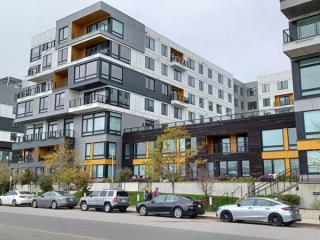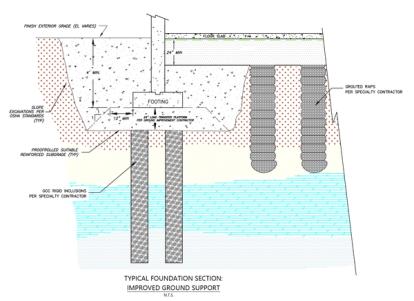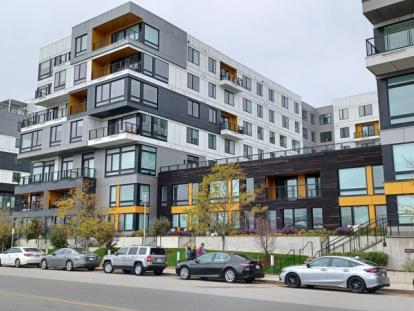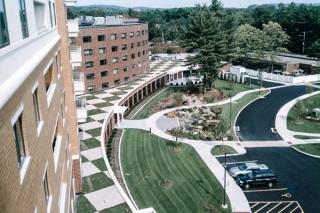
Revere Beach Apartments
- Client Name
- Hines Interests, LP
- Location
- Revere, Massachusetts, USA

This project received a 2024 Bronze Award from ACEC/MA
Challenge
The property of 646 Ocean Avenue in Revere, Massachusetts was slated to be redeveloped into a multifamily development with retail on its lowest floor. Previously used as a paved parking lot and abutted to the west by the MBTA Blue Line (a commuter train which runs between the towns of Bowdoin and Wonderland) and multi-level apartments to the north and south, this property required substantial geotechnical engineering design, subsurface explorations, cross-hole seismic testing, ground improvement recommendations, stormwater retention and treatment plans, and seismograph vibration monitoring during construction.
Due to the constraints posed by the proximity of existing developments, potential storm surge risk, and the proposed building occupying the majority of the site, this project required a multi-disciplinary team to lead the engineering design and strategy to ensure this property was designed with longevity and resiliency at its core.
Solution
SLR was selected by the developer to provide innovative engineering solutions on the development site. The project showcased SLR’s greatest strength; to provide multiple services simultaneously with an in-house team of experts who could address the developer’s needs for innovative civil, geotechnical, and environmental engineering solutions.
Subsurface Explorations
SLR provided oversight for the drilling of 39 subsurface explorations performed on the site. Soil borings with monitoring wells were installed and environmental sampling results showed an area of impacted soils. SLR served as the Licensed Site Professional of record for the environmental characterization of the site and for the disposal of contaminated soils during construction.
Seismic Site Classification and Settlement Analysis
SLR retained a subcontractor to perform cross-hole seismic testing and obtain a shear and compression wave profile for the site. Following cross-hole seismic testing results, SLR was able to increase the Seismic Site Class from E to D, resulting in significant savings in the structural design of the building. Settlement modeling for the site was performed for both elastic and consolidation conditions and included rectangular (footing) load shapes and uniform (slab) loads.
Ground Improvement
Due to the variable density of the existing fill materials and compressibility characteristics of the property’s underlying marine clay, SLR concluded traditional shallow foundations would not be suitable for the development of the property. Instead, SLR recommended a hybrid ground improvement system consisting of spread footing foundations and slabs-on-grade supported by grouted rammed aggregate piers (RAPs) founded above the top of the desiccated marine clay deposits for floor slabs and Geo-Concrete Column (GCC) rigid inclusions installed through the organic and marine clay deposits into the underlying marine sand deposits for building columns and continuous strip footings. This innovative hybrid approach was designed to meet the needs of the constrained site without sacrificing structural quality, construction cost, or future occupier safety.
Stormwater Retention and Storm Surge
Being a coastal property, resiliency against storm surges was imperative to the success of this project. The lower-level parking garage portion of the building was designed so that storm surge flowed through the garage and was designed to resist uplift (buoyancy) from elevated water levels. The lower-level retail was raised above potential storm surge elevations, ensuring that minimal property damage would befall tenants on the lowest level of the property.
Due to the limited nature of the property’s available space, stormwater retention galleries as well as an oil/water separator were designed into the building footprint, located below the first-floor slab.
Seismograph Vibration Monitoring During Construction
SLR performed vibration monitoring at the MBTA tracks and at adjacent apartment buildings during ground improvement. Vibration monitoring was performed using seismograph and geophone. Vibration monitoring results documented that no allowable vibration thresholds were exceeded during ground improvement.
Impact
SLR’s contributions to the multifamily development concluded in March 2023, providing the client innovative ground improvement/foundational support for their coastal property, an on-site stormwater treatment solution, and provided property resiliency against storm surges.
The 209-unit property is expecting occupancy by the third quarter of 2024.
“From inception to completion of the geotechnical engineering work, SLR worked closely with our firm and other specialty contractors for the project. We are proud of the engineering work and detail completed by SLR.”
David Walker, Hines Interests, LP




